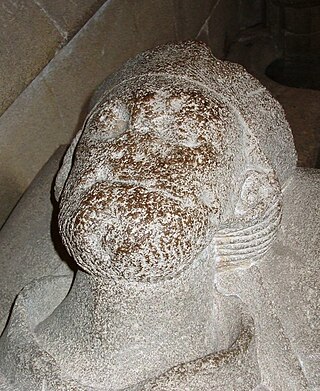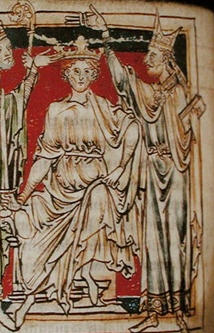
Ealdred was Abbot of Tavistock, Bishop of Worcester, and Archbishop of York in early medieval England. He was related to a number of other ecclesiastics of the period. After becoming a monk at the monastery at Winchester, he was appointed Abbot of Tavistock Abbey in around 1027. In 1046 he was named to the Bishopric of Worcester. Ealdred, besides his episcopal duties, served Edward the Confessor, the King of England, as a diplomat and as a military leader. He worked to bring one of the king's relatives, Edward the Exile, back to England from Hungary to secure an heir for the childless king.
Ælfheah, more commonly known today as Alphege, was an Anglo-Saxon Bishop of Winchester, later Archbishop of Canterbury. He became an anchorite before being elected abbot of Bath Abbey. His reputation for piety and sanctity led to his promotion to the episcopate and, eventually, to his becoming archbishop. Ælfheah furthered the cult of Dunstan and also encouraged learning. He was captured by Viking raiders in 1011 during the siege of Canterbury and killed by them the following year after refusing to allow himself to be ransomed. Ælfheah was canonised as a saint in 1078. Thomas Becket, a later Archbishop of Canterbury, prayed to Ælfheah just before his murder in Canterbury Cathedral in 1170.
Pope Alexander II, born Anselm of Baggio, was the head of the Roman Catholic Church and ruler of the Papal States from 1061 to his death in 1073. Born in Milan, Anselm was deeply involved in the Pataria reform movement. Elected according to the terms of his predecessor's bull, In nomine Domini, Anselm's was the first election by the cardinals without the participation of the people and minor clergy of Rome. He also authorized the Norman Conquest of England in 1066.

Lanfranc, OSB was a celebrated Italian jurist who renounced his career to become a Benedictine monk at Bec in Normandy. He served successively as prior of Bec Abbey and abbot of St Stephen's Abbey in Caen, Normandy and then as Archbishop of Canterbury in England, following its conquest by William the Conqueror. He is also variously known as Lanfranc of Pavia, Lanfranc of Bec, and Lanfranc of Canterbury. In his lifetime, he was regarded as the greatest theologian of his generation.

Stigand was an Anglo-Saxon churchman in pre-Norman Conquest England who became Archbishop of Canterbury. His birth date is unknown, but by 1020 he was serving as a royal chaplain and advisor. He was named Bishop of Elmham in 1043, and was later Bishop of Winchester and Archbishop of Canterbury. Stigand was an advisor to several members of the Anglo-Saxon and Norman English royal dynasties, serving six successive kings. Excommunicated by several popes for his pluralism in holding the two sees, or bishoprics, of Winchester and Canterbury concurrently, he was finally deposed in 1070, and his estates and personal wealth were confiscated by William the Conqueror. Stigand was imprisoned at Winchester, where he died.
Robert of Jumièges was the first Norman Archbishop of Canterbury. He had previously served as prior of the Abbey of St Ouen at Rouen in Normandy, before becoming abbot of Jumièges Abbey, near Rouen, in 1037. He was a good friend and adviser to the king of England, Edward the Confessor, who appointed him bishop of London in 1044, and then archbishop in 1051. Robert's time as archbishop lasted only about eighteen months. He had already come into conflict with the powerful Earl Godwin and, while archbishop, made attempts to recover lands lost to Godwin and his family. He also refused to consecrate Spearhafoc, Edward's choice to succeed Robert as Bishop of London. The rift between Robert and Godwin culminated in Robert's deposition and exile in 1052.

Thomas of Bayeux was Archbishop of York from 1070 until 1100. He was educated at Liège and became a royal chaplain to Duke William of Normandy, who later became King William I of England. After the Norman Conquest, the king nominated Thomas to succeed Ealdred as Archbishop of York. After Thomas' election, Lanfranc, Archbishop of Canterbury, demanded an oath from Thomas to obey him and any future Archbishops of Canterbury; this was part of Lanfranc's claim that Canterbury was the primary bishopric, and its holder the head of the English Church. Thomas countered that York had never made such an oath. As a result, Lanfranc refused to consecrate him. The King eventually persuaded Thomas to submit, but Thomas and Lanfranc continued to clash over ecclesiastical issues, including the primacy of Canterbury, which dioceses belonged to the province of York, and the question of how York's obedience to Canterbury would be expressed.

Gisa was Bishop of Wells from 1060 to 1088. A native of Lorraine, Gisa came to England as a chaplain to King Edward the Confessor. After his appointment to Wells, he travelled to Rome rather than be consecrated by Stigand, the Archbishop of Canterbury. As bishop, Gisa added buildings to his cathedral, introduced new saints to his diocese, and instituted the office of archdeacon in his diocese. After the Norman Conquest, Gisa took part in the consecration of Lanfranc, the new Archbishop of Canterbury, and attended Lanfranc's church councils. His tomb in Wells Cathedral was opened in the 20th century and a cross was discovered in his tomb.
Grimketel was an English clergyman who went to Norway as a missionary and was partly responsible for the conversion of Norway to Christianity. He initiated the beatification of Saint Olaf. On his return to England he became Bishop of Selsey and also for a time Bishop of Elmham. He was accused, by some, of being guilty of simony.
Æthelric was the second to last medieval Bishop of Selsey in England before the see was moved to Chichester. Consecrated a bishop in 1058, he was deposed in 1070 for unknown reasons and then imprisoned by King William I of England. He was considered one of the best legal experts of his time, and was even brought from his prison to attend the trial on Penenden Heath where he gave testimony about English law before the Norman Conquest of England.
Stigand was the last Bishop of Selsey, and first Bishop of Chichester.

The Accord of Winchester is the 11th-century document that establishes the primacy of the archbishop of Canterbury over the archbishop of York.

Remigius de Fécamp was a Benedictine monk who was a supporter of William the Conqueror.

Walkelin was the first Norman Bishop of Winchester. He began the construction of Winchester Cathedral in 1079 and had the Old Minster demolished. He reformed the cathedral's administration, although his plan to replace the monks with priests was blocked by the Archbishop of Canterbury, Lanfranc. Walkelin was important in beginning St Giles's Fair in Winchester and was greatly active in national politics. For example, he signed the Accord of Winchester, was involved in the Council of London in 1075, and sought to resolve a conflict between Anselm of Canterbury and William II. He was regent of England for a few months at the end of his life.
Godfrey was a medieval Bishop of Chichester. The first Bishop of Chichester was Stigand, who died in 1087; it seems that he was followed by Godfrey. Confusion over the succession was generated by William of Malmesbury, who suggested that Stigand was succeeded by a Bishop William.
Leofwin was a medieval Bishop of Lichfield.
Events from the 1070s in England.
The Council of London in 1075 was a council of the Catholic Church in England held by the new Norman archbishop of Canterbury Lanfranc five years after his installation. Other attendees included Gisa, Bishop of Wells and William the Norman. The Council of London produced several decrees, these were known as the "Canons of the Council of London AD 1075".
The Canterbury–York dispute was a long-running conflict between the archdioceses of Canterbury and York in medieval England. It began shortly after the Norman Conquest of England and dragged on for many years. The main point of the dispute was over whether Canterbury would have jurisdiction, or primacy, over York. A number of archbishops of Canterbury attempted to secure professions of obedience from successive archbishops of York, but in the end they were unsuccessful. York fought the primacy by appealing to the kings of England as well as the papacy. In 1127, the dispute over the primacy was settled mainly in York's favour, for they did not have to submit to Canterbury. Later aspects of the dispute dealt with concerns over status and prestige.

The coronation of William the Conqueror as King of England took place at Westminster Abbey, London, on 25 December 1066, following the Norman Conquest of England. It was the first coronation which can be proved to have been held at Westminster. In May 1068, William's wife, Matilda of Flanders, was also crowned at the abbey. At Easter in 1070, William was crowned for a second time at Winchester by three papal legates, to confirm the acceptance of his rule by the Catholic Church.









